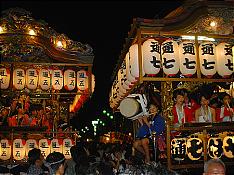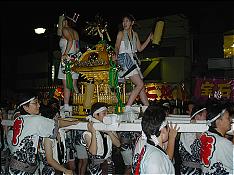
There are countless local festivals (matsuri) in Japan because almost every shrine celebrates one of its own. Most festivals are held annually and celebrate the shrine's deity or a seasonal or historical event. Some festival are held over several days.
 |  |
Many festivals also feature decorated floats (dashi), which are pulled through the town, accompanied by drum and flute music by the people sitting on the floats. Every festival has its own characteristics. While some festivals are calm and meditative, many are energetic and noisy.
Below follows an incomplete list of some of Japan's most famous festivals and celebrations. Exact dates are available on the event calendar :
Sapporo Snow Festival(Yuki Matsuri)
The Sapporo Snow Festival (Sapporo Yuki Matsuri) is held during one week every February in Hokkaido's capital Sapporo. In 2011, the Snow Festival will be held from February 7 through February 13, 2011.
[Read more of this review]
Omizutori-Nara
Omizutori is the commonly used name for Shunie, a series of events held annually from March 1 to 14 at Todaiji Temple. This collection of Buddhist repentance rituals has been held every year for over 1250 years, making it the one of the oldest reoccurring Buddhist events in Japan.
[Read more of this review]
Takayama Festival
The Spring Festival (April 14-15) is the annual festival of the Hie Shrine in the southern half of Takayama's old town. While the shrine is also known as Sanno-sama, the spring festival is also called Sanno Festival.
[Read more of this review]
Kyoto Gion Matsuri
Gion Matsuri, the festival of Yasaka Shrine, is the most famous festival in Japan. It takes place over the entire month of July. There are many different events, but two are particularly renowned: the Yamaboko Junko, a procession of floats on July 17th; and Yoiyama, the festive evenings preceding the procession.
[Read more of this review]
Nebuta Matsuri-Aomori
Nebuta and Neputa are a type of Tanabata related summer festival held in towns around Aomori Prefecture. The largest of these festivals is the Nebuta Matsuri of Aomori City, held every year from August 2 to 7. The highlight of the festival is the daily parade of enormous lantern floats, flanked by large taiko drums, musicians and dancers.
[Read more of this review]
Kanto Matsuri
The Kanto Matsuri ("pole lantern festival") is a Tanabata related celebration in Akita City, held every year from August 3rd to 6th. The highlight of the festival is an impressive display of skill in which performers balance kanto, or long bamboo poles with arrays of paper lanterns attached to the end.
[Read more of this review]
Awa Odori-Tokushima
Between August 12th and 15th, spectators and dancers come to Tokushima in the thousands to see this "Fool's Dance" whose origins date back 400 years. This nickname comes from the lyrics to a common dance song, which translates as follows: "Fools dance and fools watch, if both are fools, you might as well dance".
[Read more of this review]
Nagasaki Kunchi Festival
The festival highlight are dance and show performances by groups representing Nagasaki's various city districts. Each district (odori-cho), participates only once every seven years, so this festival remains fresh to even the regular viewer.
[Read more of this review]
Jidai Matsuri-Kyoto
Jidai Matsuri is Japanese for "Festival of Ages", and the participants of the parade are dressed in accurate costumes from almost every period of Japanese history, as well as famous historical figures. There are about 2000 participants and it takes two hours to watch the entire procession pass by.
[Read more of this review]
Chichibu Night Festival
The Chichibu Night Festival is considered one of Japan's top three festivals to feature floats, the others being Kyoto's Gion Matsuri and the Takayama Matsuri. Its floats are ornately decorated with lanterns, tapestries and gilded wood carvings, and are accompanied by drum and flute music.
[Read more of this review]














No comments:
Post a Comment